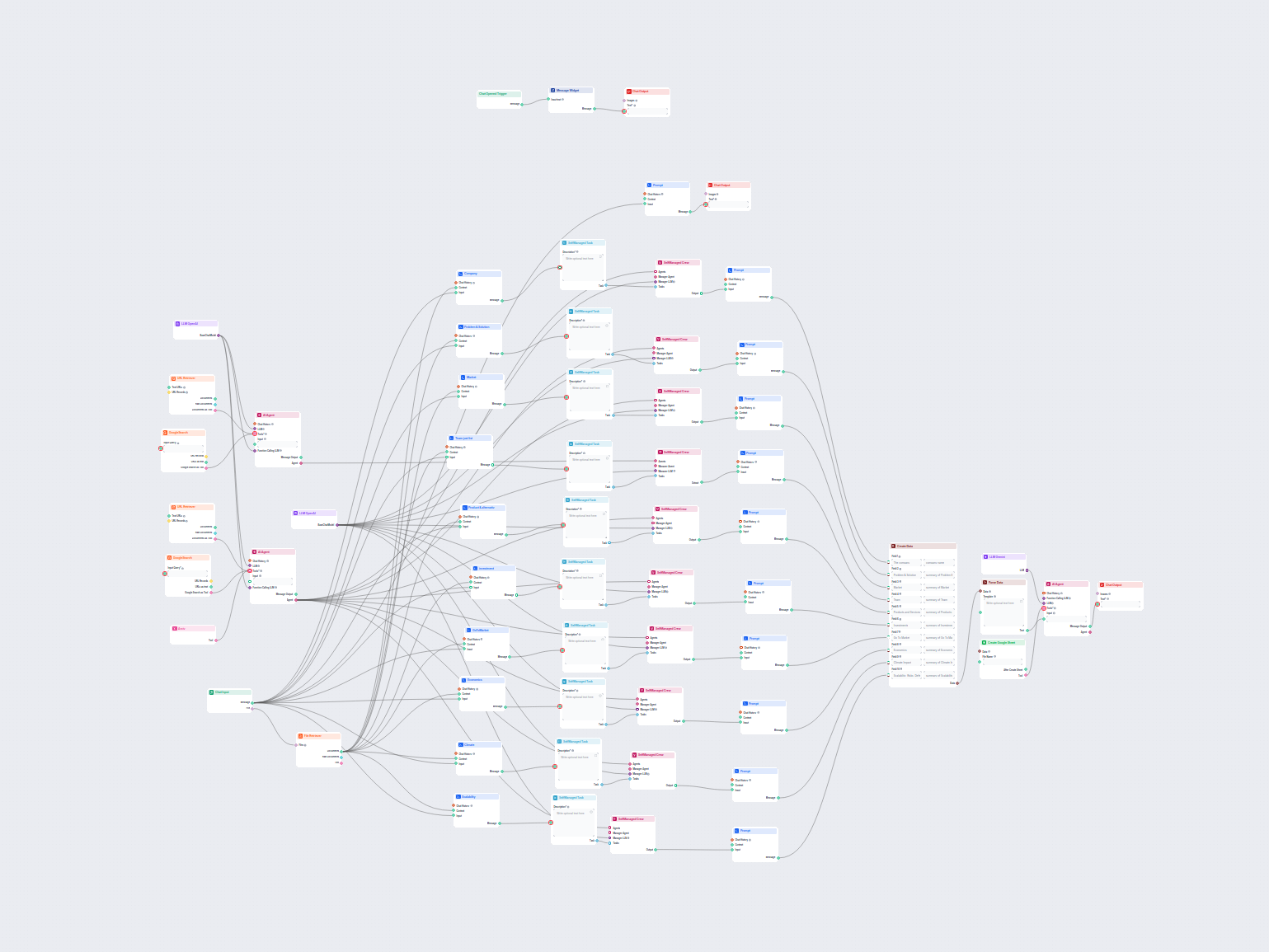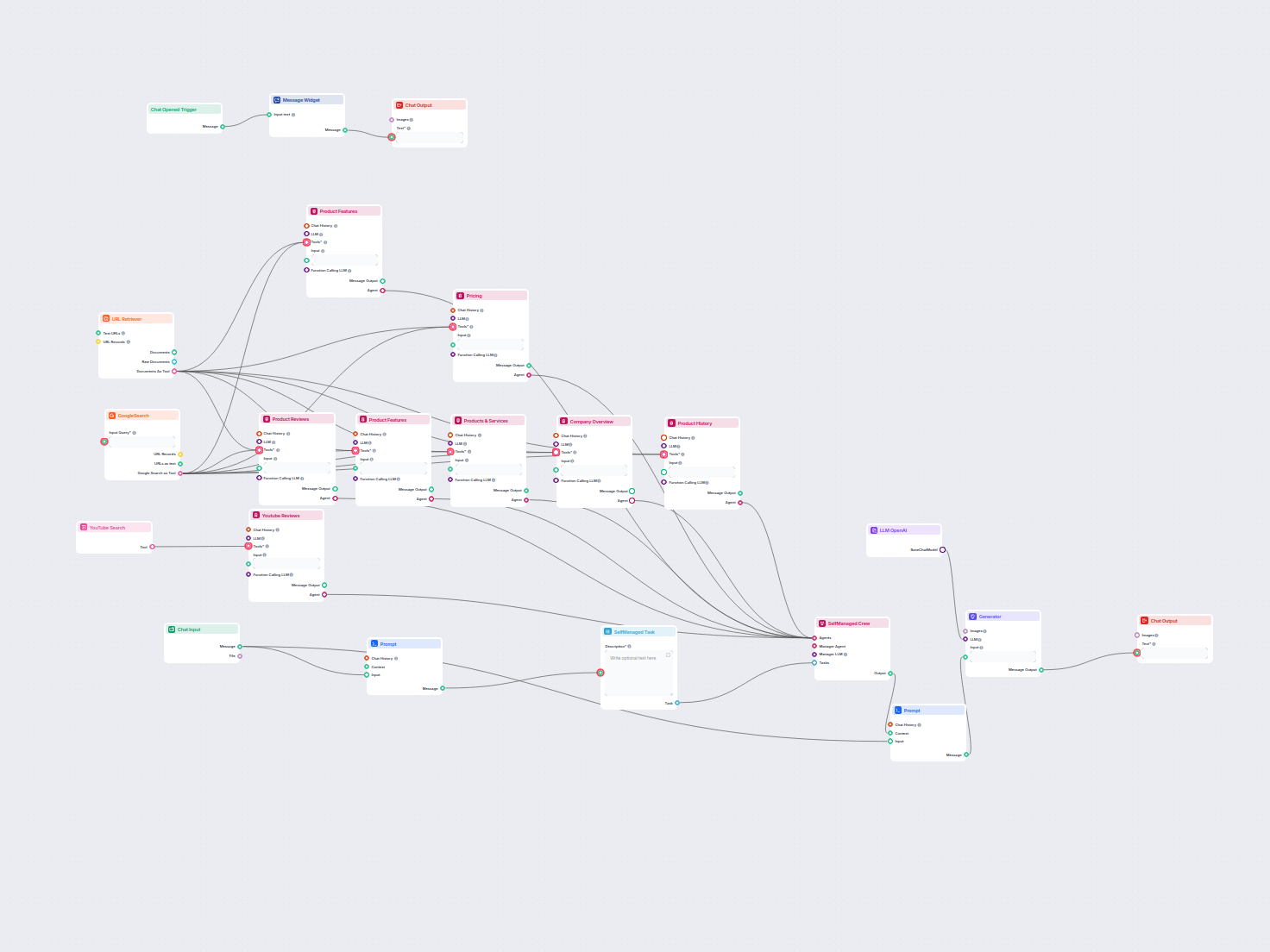Company
Prompt to extract company overview, history, and notable achievements.
This AI-powered workflow delivers a comprehensive, data-driven company analysis. It gathers information on company background, market landscape, team, products, investments, and financials using advanced AI agents and web research, then exports all findings into a structured Google Sheet for easy review and sharing. Ideal for investors, business strategists, and analysts seeking actionable insights into any company’s market position and growth potential.

Flows
Prompt to extract company overview, history, and notable achievements.
Prompt to extract the main problem the company solves and its solution.
Prompt to extract information about the target market, size, opportunities, and competition.
Prompt to extract a list of team members and their roles.
Prompt to extract company's main products/services, alternatives, and competitive advantages.
Prompt to extract investment and funding information about the company.
Prompt to extract go-to-market strategy, business model, and timing.
Prompt to extract unit economics, revenue, and traction data.
Prompt to extract the company's impact on climate.
Prompt to extract scalability, defensibility, and key risks.
Below is a complete list of all components used in this flow to achieve its functionality. Components are the building blocks of every AI Flow. They allow you to create complex interactions and automate tasks by connecting various functionalities. Each component serves a specific purpose, such as handling user input, processing data, or integrating with external services.
The Chat Input component in FlowHunt initiates user interactions by capturing messages from the Playground. It serves as the starting point for flows, enabling the workflow to process both text and file-based inputs.
The Message Widget component displays custom messages within your workflow. Ideal for welcoming users, providing instructions, or showing any important information, it supports Markdown formatting and can be set to appear only once per session.
Discover the Chat Output component in FlowHunt—finalize chatbot responses with flexible, multi-part outputs. Essential for seamless flow completion and creating advanced, interactive AI chatbots.
Learn how FlowHunt's Prompt component lets you define your AI bot’s role and behavior, ensuring relevant, personalized responses. Customize prompts and templates for effective, context-aware chatbot flows.
The File Retriever component in FlowHunt lets you bring files into your workflow and convert them into documents for further processing. It supports strategies for handling multiple documents and can use OCR on images within files, making it ideal for extracting and transforming information from a wide variety of file types.
Unlock web content in your workflows with the URL Retriever component. Effortlessly extract and process the text and metadata from any list of URLs—including web articles, documents, and more. Supports advanced options like OCR for images, selective metadata extraction, and customizable caching, making it ideal for building knowledge-rich AI flows and automations.
FlowHunt's GoogleSearch component enhances chatbot accuracy using Retrieval-Augmented Generation (RAG) to access up-to-date knowledge from Google. Control results with options like language, country, and query prefixes for precise and relevant outputs.
FlowHunt supports dozens of text generation models, including models by OpenAI. Here's how to use ChatGPT in your AI tools and chatbots.
FlowHunt supports dozens of AI models, including Google Gemini. Learn how to use Gemini in your AI tools and chatbots, switch between models, and control advanced settings like tokens and temperature.
Effortlessly chat with 2.4M scholarly articles using FlowHunt's ArXiv Tool and AI Agents. Revolutionize your research by matching queries with concise responses from the ArXiv database and enhance your chatbot with customizable flows.
The AI Agent component in FlowHunt empowers your workflows with autonomous decision-making and tool-using capabilities. It leverages large language models and connects to various tools to solve tasks, follow goals, and provide intelligent responses. Ideal for building advanced automations and interactive AI solutions.
The SelfManaged Task component enables users to define and execute autonomous tasks within a workflow. Specify a clear task description, expected outcome, and assign an agent to manage execution—ideal for building structured, hierarchical automation in your flows.
Unlock advanced collaboration in FlowHunt with the Self-Managed Crew component. Coordinate multiple AI agents under a manager agent to autonomously handle complex workflows and hierarchical tasks, maximizing efficiency and scalability.
The Create Data component enables you to dynamically generate structured data records with a customizable number of fields. Ideal for workflows that require the creation of new data objects on the fly, it supports flexible field configuration and seamless integration with other automation steps.
The Parse Data component transforms structured data into plain text using customizable templates. It enables flexible formatting and conversion of data inputs for further use in your workflow, helping to standardize or prepare information for downstream components.
Easily generate new Google Sheets directly within your workflow. The Create Google Sheet component lets you input structured data and instantly create spreadsheets, making it simple to automate data collection, reporting, or sharing results. Integrate with other components to streamline your business and productivity tasks.
Flow description
The “AI Company Analysis Tool Exported to Google Sheets” is an advanced, modular workflow designed to generate a comprehensive, data-driven analysis of any company. It leverages multiple AI agents, prompt templates, data retrieval tools, and automated export capabilities to Google Sheets. This flow is ideal for investors, business strategists, analysts, and anyone requiring a deep dive into a company’s history, market position, products, team, challenges, opportunities, and future prospects—all systematically organized in a format that is easy to manage and share.
The workflow is modular, with separate tasks (crews and sub-tasks) for each analytical section. Each section uses prompt engineering to ensure thorough and focused outputs.
These sections include:
| Section | Key Analytical Focus |
|---|---|
| Company Overview | Brief summary, history, notable achievements (with sources/links) |
| Problem & Solution | Company’s core problem statement and their unique solution |
| Market Analysis | Target customer, market size, background, opportunities, competition (size, funding, leaders) |
| Team | Key team members, their roles, and background (via search and document analysis) |
| Products & Services | Main products/services, key features, alternatives, and competitive advantages (with links) |
| Investments | Funding raised, investors, fundraising details, upcoming rounds, investor summaries with links |
| Go To Market | Technology readiness, distribution strategies, business model, timing, and market shifts |
| Economics & Traction | Unit economics, cost breakdown, revenue numbers and projections, notable traction milestones |
| Climate Impact | Direct impact on climate/greenhouse gas emissions, mechanism of impact |
| Scalability, Risks, Defensibility | Global scalability, business defensibility, key risks |
For each analytical area, the workflow uses a prompt template with dynamic variables and context injection (from files, web, etc.) to generate detailed, accurate, and referenced outputs.
| Field | Description |
|---|---|
| The company | Company name, overview, history, achievements |
| Problem & Solution | Problem addressed and company’s solution |
| Market | Market size, focus, competitors, opportunities |
| Team | List of key team members with roles |
| Products and Services | Product/service description, alternatives, advantages |
| Investments | Funding details, investors, fundraising rounds |
| Go To Market | Strategy, business model, timing, technology readiness |
| Economics | Costs, revenue, projections, traction |
| Climate Impact | Environmental impact and explanation |
| Scalability, Risks, Defensibility | Assessment of scalability, risks, and defensibility |
This workflow turns what is traditionally a manual, labor-intensive company analysis into a fully automated and scalable process. By combining AI research, structured prompt engineering, external and internal data sources, and automated export to Google Sheets, it empowers users to generate investment-grade company reports in minutes instead of days—making it a powerful tool for investors, analysts, and business operators alike.
We help companies like yours to develop smart chatbots, MCP Servers, AI tools or other types of AI automation to replace human in repetitive tasks in your organization.
This AI workflow analyzes any company in depth by researching public data and documents, covering market, team, products, investments, and more. It synthesizes ...
Comprehensive AI-driven workflow for company analysis and market research. Automatically gathers and analyzes data on company background, market position, produ...
Generate comprehensive product analyses using AI agents that gather and summarize product information, pricing, features, reviews, alternatives, and more from p...
Cookie Consent
We use cookies to enhance your browsing experience and analyze our traffic. See our privacy policy.



